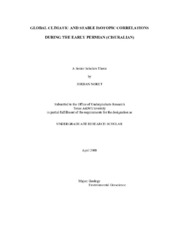| dc.description.abstract | The early Permian was an interval when cool, glaciated conditions, similar to those of the present-day, shifted to warm, non-glaciated conditions. As a result, climatological information about this time period is pertinent in studying the causes and effects of global warming. This study presents new oxygen and carbon stable isotopic data (δ18O and δ13C, VPDB) from carefully screened, early Permian brachiopod shells from the Ural Mountains. Using cathodoluminescence (CL) microscopy, 24 specimens were determined to be well-preserved and were used for 95 stable isotopic analyses. Interspecimen
variability within each time horizon was lower than 0.5‰ and intra-specimen variability was lower than 0.2‰.
The δ18O values of the specimens analyzed average between -2.2‰ and -2.7‰
Through the Asselian, Sakmarian, and early Artinskian (297-283 Ma). Values then rapidly increase by 3‰ in the late Artinskian and early Kungurian (~275 Ma). The
low values before the Kungurian do not suggest glacial conditions and thus disagree
with the geological evidence for a glacial maximum during the Asselian. These data
also disagree with the early Permian maximum and subsequent decline in δ18O
suggested from brachiopod shell fragments from the Usolka section in the Urals (Korte
et al., 2005. Palaeogeog., Palaeoclim., Palaeoecol. 224, 333-351). However, our data are similar to those obtained from other brachiopods (Grossman et al., 2008. Palaeogeog.,
Palaeoclim., Palaeoecol. 268, 222-233). The cause of this discrepancy is unknown, but
could be a result of differences in regional oceanographic factors, glacial/interglacial conditions, or in source material (i.e. wholly preserved shells versus shell fragments).
The Artinskian- Kungurian increase in δ18O from this study is evidence for the aridification of the epicontinental seas of Laurussia and possibly a return to cooler conditions.
The δ13C data from the specimens discussed in this study show a gradual decrease of about 1.5‰ from the late Asselian to the Artinskian, followed by a sharp increase of about 1.5‰ in the late Artinskian. This δ13C increase is not seen in previously published data from Russia or North America. Further work is required before any strong conclusions can be made on global δ13C variability during the early Permian. | en |


